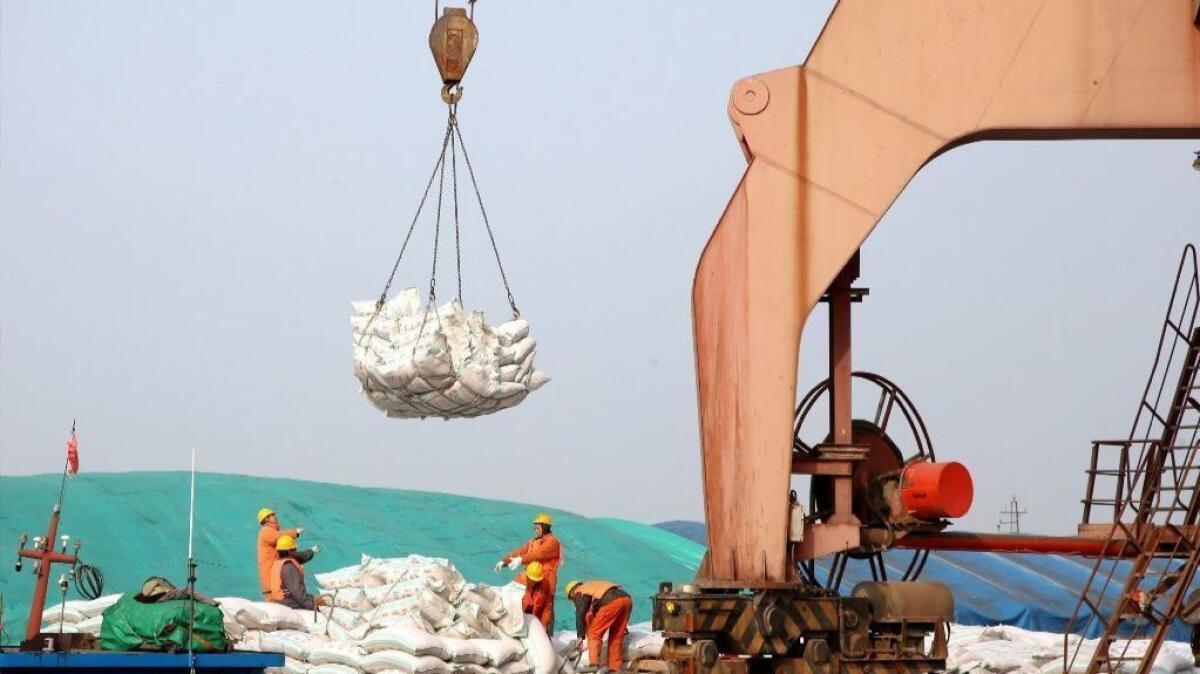As U.S.-China tit-for-tat tariffs kick in, hereâs what could happen

U.S. businesses and consumers were bracing for a major escalation in the United Statesâ trade dispute with China after a tariff hike on Chinese imports took effect Thursday night on the West Coast.
The Trump administration imposed added tariffs on hundreds of Chinese products in a bid to narrow the U.S. trade deficit with China.
The tariffs kicked in at 9:01 p.m. PDT Thursday. China vowed to immediately retaliate with added tariffs of its own on a variety of U.S. goods.
Shortly after 9 p.m. PDT, Beijing said it âmust counterattackâ for the U.S. move but gave no immediate details.
A Commerce Ministry statement said, âthe Chinese side promised not to fire the first shot, but to defend the core interests of the country and people, it is forced to make a necessary counterattack.â
A trade war between the worldâs two biggest economies could upset the global economy, threaten U.S. exports to China and force American consumers to pay higher prices for some Chinese-made goods.
Hereâs a look at the key issues in the dispute:
How did we get to this point?
Trump has repeatedly decried the U.S. trade deficit with China, which totaled $375.6 billion last year, and the nationâs deficits with other trading partners, arguing that those countries maintain higher trade barriers relative to the United States, leaving America at a disadvantage.
âThey must play fair or they will pay tariffs!â Trump tweeted June 26. He also has said the tariffs would be in response to what the administration claims is Chinese theft of U.S. intellectual property.
China then announced it would respond with added tariffs of its own on U.S.-made goods to protect its economic interests.
What happens next?
The United States has announced it will impose an additional 25% tariff on 818 categories of products from China valued at $34 billion. Tariffs on an additional $16 billion of Chinese goods also are planned for a later date.
The Chinese products include a variety of farm machinery, industrial products, medical devices, some motor vehicles and aircraft parts. They do not include such finished consumer goods as smartphones.
China has vowed to immediately respond with equivalent tariffs on U.S. products including soybeans, other farm crops, dairy products and automobiles.
âChina will not bow in the face of threats and blackmail, nor will it be shaken in its resolve to defend global free trade,â Commerce Ministry spokesman Gao Feng said at a news conference Thursday.
âChina will never fire the first shot,â he added. âHowever, if the United States adopts taxation measures, China will be forced to fight back to defend the core interests of the nation and the interests of the people.â
Whatâs the potential impact of these moves?
U.S. Chamber of Commerce President Thomas Donohue maintained that the tariffs âare beginning to take a toll on American businesses, workers, farmers and consumers as overseas markets close to American-made products and prices increase here at home.â
While only 1% of the Chinese products set for the new tariffs are finished consumer goods, according to a Reuters analysis, additional taxes on Chinese goods in the supply chain might result in higher prices for U.S. manufacturers and other firms that buy those goods â higher prices that get passed on to customers.
Perhaps the overarching concern is that the dispute could turn into a wider, protracted trade fight if the two sides continue raising tariffs on thousands of additional products instead of negotiating a settlement.
What could be the fallout if that happens?
Some analysts are worried that it could slow the economic expansion and jobs growth that the United States has enjoyed over the last 12 months.
That wonât be clear until itâs known how much the tariffs reduce what the United States buys from China and vice versa, and whether both sides can find alternative buyers for some or all of their products elsewhere in the world.
But Trump administration officials contend the trade concerns are overblown in terms of harming American workers and that fairer trade with China ultimately will benefit U.S. companies and workers.
âWe think youâll continue to see very strong employment,â Commerce Secretary Wilbur Ross told Bloomberg Television last week.
Still, if a separate trade dispute with Europe is any measure, that optimism may not be warranted.
The European Unionâs retaliation to levies the Trump administration has imposed on steel and aluminum imports prompted Harley-Davidson Inc. to shift production of motorcycles destined for Europe to overseas plants.
How have investors reacted to all of this?
The U.S.-China dispute, which has been brewing for months, has weighed on the U.S. stock market because itâs added to uncertainty about global economic growth, corporate earnings and consumer spending. But the market closed up modestly Thursday as the potential tariffs drew closer.
The benchmark Standard & Poorâs 500 index is up 2% so far this year, and the technology-heavy Nasdaq composite index has climbed 9%. Both measures enjoyed double-digit percentage gains last year.
The trade dispute has hurt Chinese stocks more, with the benchmark Chinese stock index tumbling 19% so far this year.
Twitter: @PeltzLATimes
UPDATES:
9:20 p.m.: Updated with a statement from Beijing.
3:50 p.m.: This article was updated with quotes from Chinese Ministry spokesman Gao Feng.
This article was originally published at 9:55 a.m.
More to Read
Inside the business of entertainment
The Wide Shot brings you news, analysis and insights on everything from streaming wars to production â and what it all means for the future.
You may occasionally receive promotional content from the Los Angeles Times.









